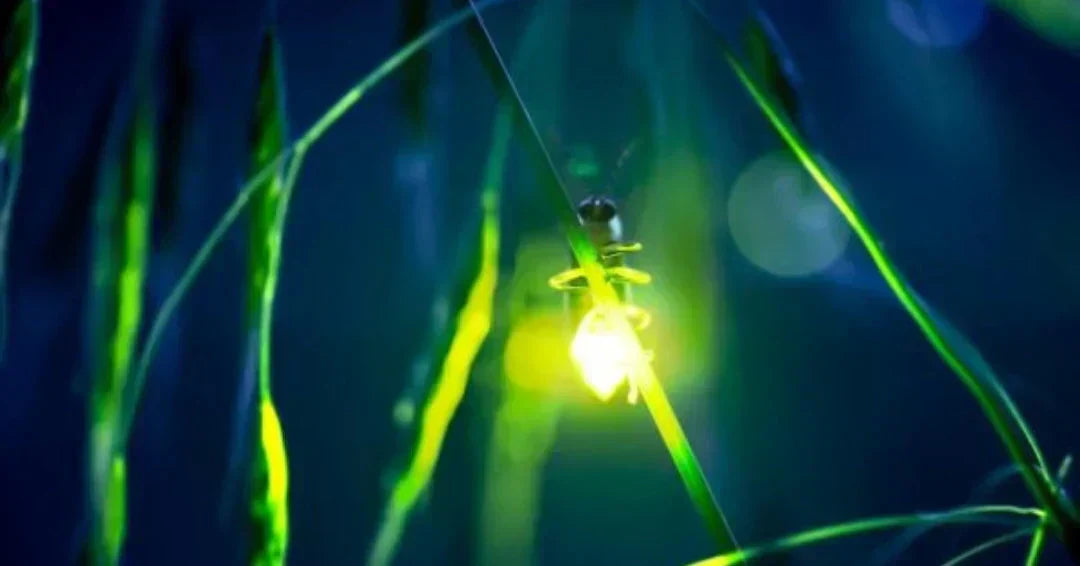Hot summer nights when twinkly lights flash on and off amongst the tall grass and trees elicit feelings of nostalgia. Adults remember their carefree childhood years running around with neighbors, chasing the delightful bugs that come out when darkness settles. Little kids love catching these delicate fireflies in their tiny hands, and then releasing them back into the dark sky. Insect-lovers will enjoy learning everything there is to know about how their lights work and the way they use them to communicate. There are so many interesting facts about fireflies to share with children next time they head outdoors to chase these beautiful bugs.

Everything to Know About Fireflies
Something pretty magical happens during the warm summer months after the sun sets and the sky turns dark. Twinkly little lights appear in the grass and trees as delicate little bugs show off their yellow light. Little ones are enticed to run outside and chase them around the yard, squealing with delight when they capture a little insect and then set it free again into the night. For kids who want to know more, read on for intriguing information about fireflies including about all the species, how they communicate, what makes them glow, and so much more. Once you have piqued the interest of your little ones by reading children's books about fireflies , they will want to head outside to observe these insects in action. Here are some interesting facts to share about these little luminaries to further satisfy their curious minds.
Why Kids Love Learning About Lightning Bugs
For many kids, learning about lightning bugs is an enchanting experience that combines the magic of nature with a fun, hands-on activity. The most captivating thing about lightning bugs is their ability to glow. A child sees a tiny flash of light in the darkness, and it feels like pure magic. This "cold light" is actually a chemical reaction called bioluminescence, and it makes the bugs seem like living stars. This mysterious and beautiful phenomenon instantly captures a child's imagination. For many kids, learning about lightning bugs is an enchanting experience that combines the magic of nature with a fun, hands-on activity. Unlike many animals that are difficult to find, lightning bugs are easy for kids to interact with. The simple summer ritual of catching them in a jar or just watching them flicker in the backyard creates a direct connection with the natural world. This accessible, hands-on experience makes learning about nature fun and personal, forming a classic childhood memory.

(1) There are more than 2,200 species of fireflies!
Scientists have documented thousands of species all over the world living in predominantly temperate and tropical regions. In the United States and Canada alone, there are more than 165 different types. It's likely that many more will be discovered over time. Only some of these insects, which are part of the beetle family, actually glow. In fact, those in the western part of the United States do not have the ability to produce light.
(2) The light is the result of a chemical reaction that occurs within the light organ.
Adenosine triphosphat, oxygen, calcium and luciferin mix with the presence of an enzyme called luciferase. So although it looks like these bugs are powered by a tiny battery, it's actually chemistry that creates the light.
(3) Fireflies flash their lights to communicate.
Using a tiny organ called a lantern, fireflies emit light for a variety of reasons. Sometimes the flashing light serves as a warning sign to keep predators away. Other times, the light is used as part of a mating ritual. For instance, males use their light to attract females who are watching and waiting in nearby vegetation. When the females spots a male firefly of the same species flashing his light, she emerges from her place of hiding to engage. Lightning bugs have also been known to synchronize their flashing lights, although this is a rare event. It is associated with mating as well, where groups of male fireflies flash in unison to attract partners.

(4) Fireflies are dropping in numbers in areas with dense populations.
Just like other wildlife, the biggest threat to the future of fireflies is the loss of their natural habitat. Commercial and housing developments are replacing trees and natural vegetation that they need to thrive and survive. Outdoor lighting in these areas prevent them from seeing their flashing lights, so it becomes difficult to find mates. In addition, pesticides and climate change are also to blame for reducing the firefly population.
(5) In order to protect themselves, lightning bugs do something called reflex bleeding.
Fireflies are surrounded by predators, like birds, toads, and lizards. Since these insects are not fast enough to fly away, they need to rely on an internal mechanism to protect themselves. When under attack, fireflies use a tactic called reflex bleeding in which they they release drops of blood that taste bitter. Sometimes these drops of blood are even deadly to predators.
(6) World Firefly Day is the first weekend of July.
Designated by the Fireflyers International Network as the day to respect fireflies, this particular event is probably news to you! There are a lot of fun activities you can do to teach your kids about the importance of fireflies and how we can protect them. A good place to start is by reading stories climate change which will teach kids how they can better take care of the environment. Also, grab some non-fiction books about fireflies that address their importance in the ecosystem. The goal for this particular day is to raise general awareness which you can start right at home.
(7) The rarest firefly is called a Blue Ghost.
You have to travel to Asheville, North Carolina to catch a glimpse of this rare species that only makes an appearance for about two to four weeks every year. When mating season begins during the late spring to early summer period, the males emit a blue-white light to attract females. The surreal scene created at night is so magical it looks almost otherworldly. Instead of flashing lights, the males can hold their glow steady for at least a minute at a time, creating a sky filled with the appearance of blue streaks.
(8) Luciferase is the enzyme that produces the light fireflies emit.
The cool thing about this chemical is that it has proven useful in scientific research, specifically biotechnology. Lucerifase is useful in identifying low levels of gene expression due to its bioluminescent properties. It has also been used in both forensic and food testing laboratories. Scientists used to depend on fireflies to extract this chemical, but a synthetic version has since been developed. A growing body of researchers hope that one day this chemical will aid doctors in diagnosing diseases like cancer much more efficiently than expensive medical equipment.
(9) Lightning bugs benefit the environment in many surprising ways.
The environmental ecosystem is a delicate balance of interconnected creatures that are essential for the thriving growth of plants and vegetation. Lightning bugs, while appreciated for their sparkling beauty, are an integral part of the natural habitat. They are valuable pollinators, consuming nectar and pollen to help plants with flowers. Equally important, they eat predators that destroy the vegetation, especially soft-bodied insects like earthworms, snails, and slugs. On the flip side, they are a tasty snack for bats, though most other creatures prefer to stay away from their terrible taste and toxic composition.

(10) Some firefly species are femme fatales.
They are predators that use a deadly trick to lure in their prey. Female Photuris fireflies mimic the specific mating signals of another firefly species, the Photinus, to attract unsuspecting males. When a male flies in hoping to mate, the female Photuris catches and eats him instead. Not only does the female get a meal, but she also acquires a valuable defense mechanism. The male fireflies are filled with a bitter, toxic steroid called lucibufagin, which they produce to deter their own predators. Since the Photuris fireflies can't produce these toxins themselves, they "steal" them by consuming the males. This makes the Photuris female and her eggs unappetizing to her predators, such as jumping spiders.
(11) Bioluminescence is the most efficient light in the world.
Fireflies create their glow through a chemical reaction called bioluminescence, which is an incredibly efficient form of light. Unlike a typical light bulb that loses most of its energy as heat, the firefly's light is "cold," converting nearly 100% of its energy directly into light. For context, a standard incandescent bulb is only about 10% efficient, with the rest of the energy wasted as heat. Even modern LEDs, while much better, only reach around 40-50% efficiency. This ability to produce light without generating heat is a crucial evolutionary advantage for the firefly; if the process created heat, it would be fatal to the insect.








